In the “I-want-answers-and-I-want-them-now” business world of customer centricism, call routing can make or break your customer experience.
Picture this: a customer calls your business, gets bounced around like a pinball through seven different departments, listens to the same jazz saxophone loop 25 times, and finally hangs up to write a scathing review titled “Dante’s nine circles of phone hell.” You don’t want that to be your business.
Studies show that 83% of customers expect to interact with someone immediately after contacting a company. As customer expectations for fast, accurate service continue to rise, businesses cannot afford to let calls languish in queues or bounce between departments.
Call routing ensures every caller is efficiently connected to the right agent, reducing wait times, directing calls to the right person, at the right time, for the right reasons, and ultimately enhancing customer satisfaction.
What is call routing?
| Let’s imagine you’re the boss of a customer support center. You’ve got: Question: How would you handle incoming calls? A – Pick them up individually, randomly assigning them to whoever’s free. B – Direct them to the right agent based on the caller’s needs and the agent’s expertise. |
If you choose B, you think like a call routing system.
A call routing system works like an intelligent traffic controller for your phone lines. Based on set rules, it automatically sends incoming calls to the right person or department. Instead of making customers wait or bounce around, it helps direct calls quickly to the right destination. This means shorter wait times, smoother conversations, and a better overall experience for everyone, all without needing someone to transfer calls manually.
How does call routing work?
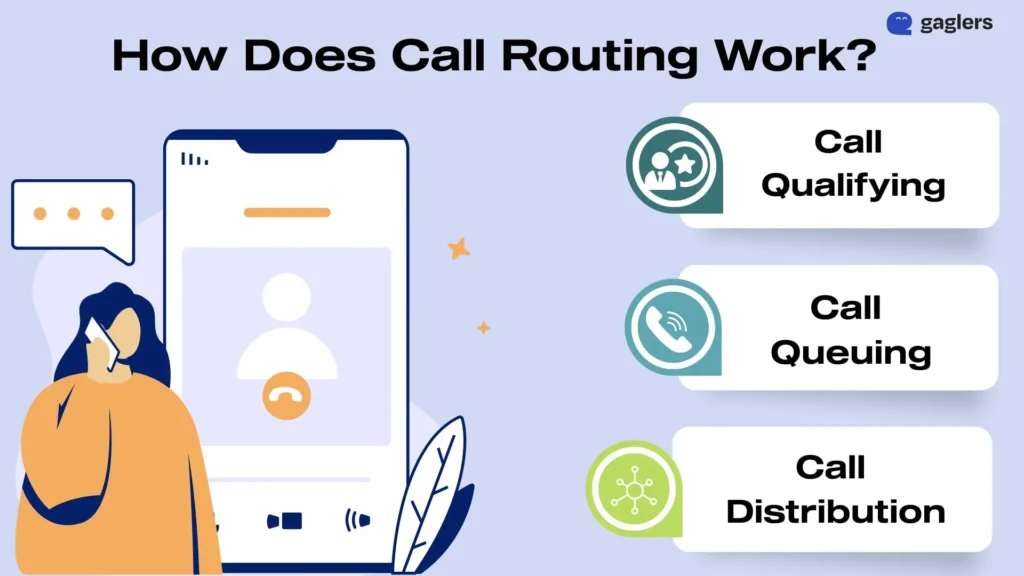
Call routing systems follow a straightforward process to manage and distribute incoming calls smoothly:
- Call qualifying: First, the system identifies who’s calling and gathers information like responses to IVR (Interactive Voice Response) prompts, phone number, or location. This step determines the caller’s needs, priority level, and preferred language.
- Call queuing: In simple terms, the calls wait in a virtual queue if all agents are busy. The system manages caller wait times and can offer options like callbacks or estimated hold times.
- Call distribution: The system uses predefined rules to route the call to the most suitable agent or department. This could be based on agent skills, availability, caller priority, or other criteria specific to a business.
Knowing how these steps work helps you see how various routing methods can be shaped to fit your business.
Are call routing and call forwarding the same?
While both send calls to another destination, they aren’t quite the same; key differences exist in how they work, how much you can customize them, and when you’d use each. Here’s a side-by-side look for comparison:
| Feature | Call routing | Call forwarding |
| Definition | Automated distribution based on rules and the caller’s needs. | Redirects calls from one number to another. |
| Purpose | Optimize call distribution and customer experience. | Ensures calls reach a specific person/device. |
| Example | Routing a Spanish speaker to a bilingual agent. | Forwarding office calls to a personal mobile phone after work hours. |
| Complexity | High – multiple rules and conditions. | Low – (simple redirect mechanism). |
| Flexibility | Highly flexible with dynamic routing. | Limited to basic forwarding rules. |
| Scalability | Scales with business growth and call volumes. | Limited scalability options. |
| Control | Complete control over call distribution | Basic control over call redirection. |
| Cost | Varies. (can be higher for advanced systems) | Low cost, basic functionality |
| Typical use case | Call centers, customer support, and sales teams. | Small businesses, personal use. |
With the table in mind, you can better assess which solution fits your business needs.
Types of call routing for business
Now that we have a clear-cut view on what call routing is, let’s dive into the different types of call routing strategies you can use to optimize customer service and operational efficiency:
1. Fixed/Sequential routing
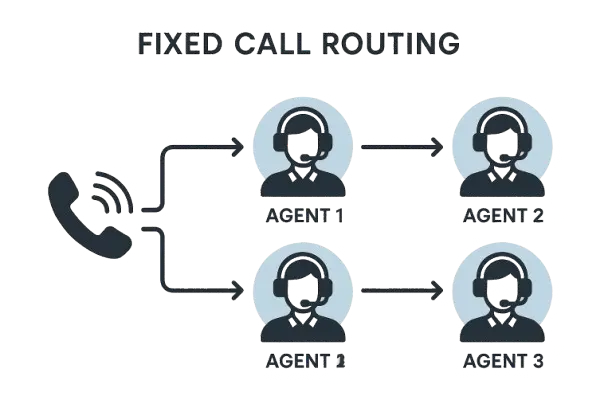
Calls are directed to agents in a predefined order. If the first agent is unavailable, the call moves to the next in line, and so on. This is simple to set up and works well for small teams or when a specific escalation path is needed.
2. Round Robin

Calls are distributed evenly amongst everyone on the team. This helps ensure a balanced workload and prevents any single agent from being overwhelmed, making it ideal for teams where all agents have similar skill sets.
3. Skill-based routing
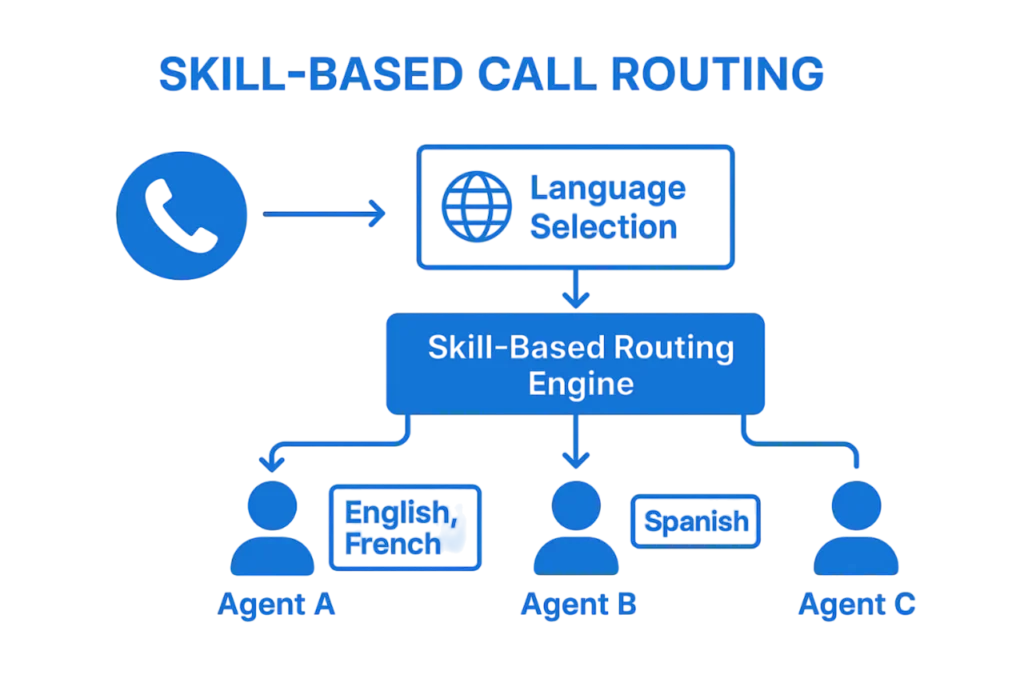
When the calls are matched to agents based on their expertise or the caller’s specific needs, it is known as skill-based routing. For example, technical inquiries go to IT specialists, while finance people handle billing issues. This approach improves first-call resolution rates and customer satisfaction by matching callers with the most qualified agents.
4. Time-based routing
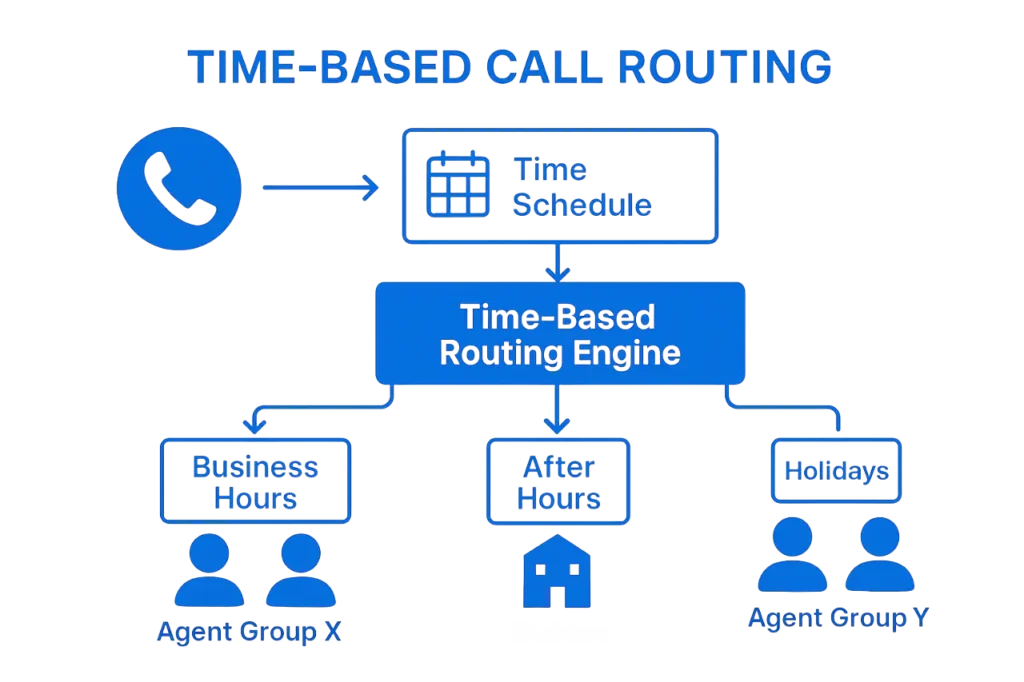
Time-based call routing sends incoming calls to different destinations depending on the time of day, your business hours, or when specific agents are available.
For example, calls after hours can be directed to voicemail, another office, or an on-call team. This setup benefits businesses with customers in different time zones or those that operate around the clock.
Let’s say a customer calls when your office is closed – their call might be sent to voicemail, redirected to another branch, or connected to whoever’s on call. This setup works exceptionally well for businesses that help clients in various zones or need to be available day and night.
Businesses can reduce call abandonment rates and ensure prompt assistance by routing calls intelligently during peak hours.
Read more: All you need to know about blended call center software to help your business maximize agent productivity and service reach.
5. Priority-based routing
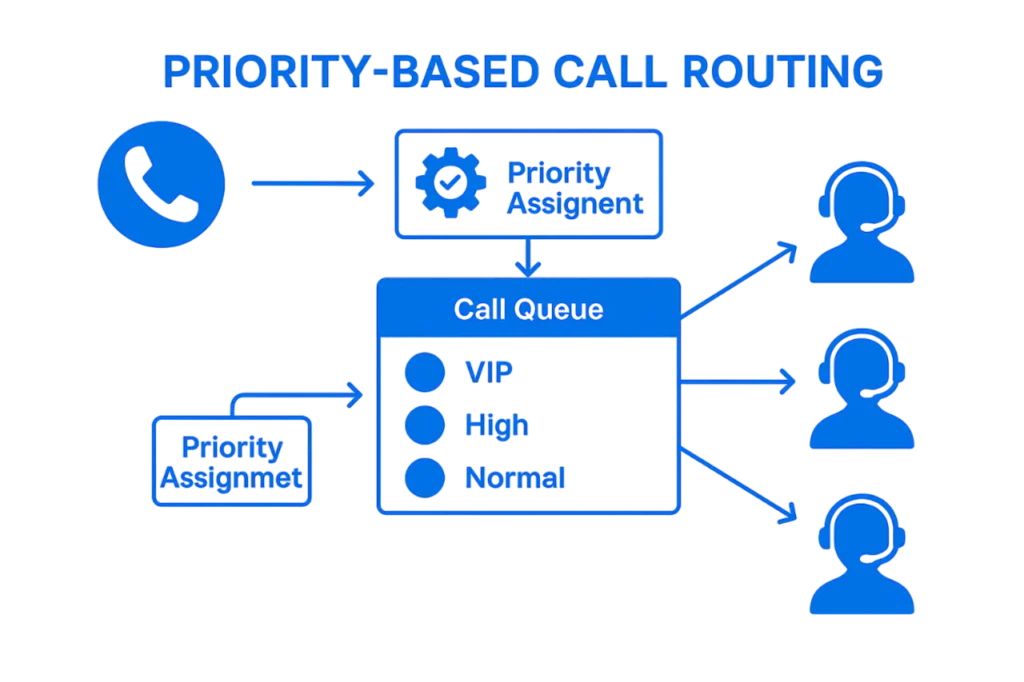
Also known as value-based routing, VIP routing ensures that essential calls, like those from top clients or urgent matters, are prioritized.
Direct high-priority calls, such as those from VIP clients or urgent issues, to the front of the queue or dedicated agents. This ensures that your most valuable customers receive prompt attention.
| Did you know? PwC research states that while 73% of consumers consider customer experience a key factor in their buying decisions, only 49% of companies deliver on those expectations. |
6. Geographical routing
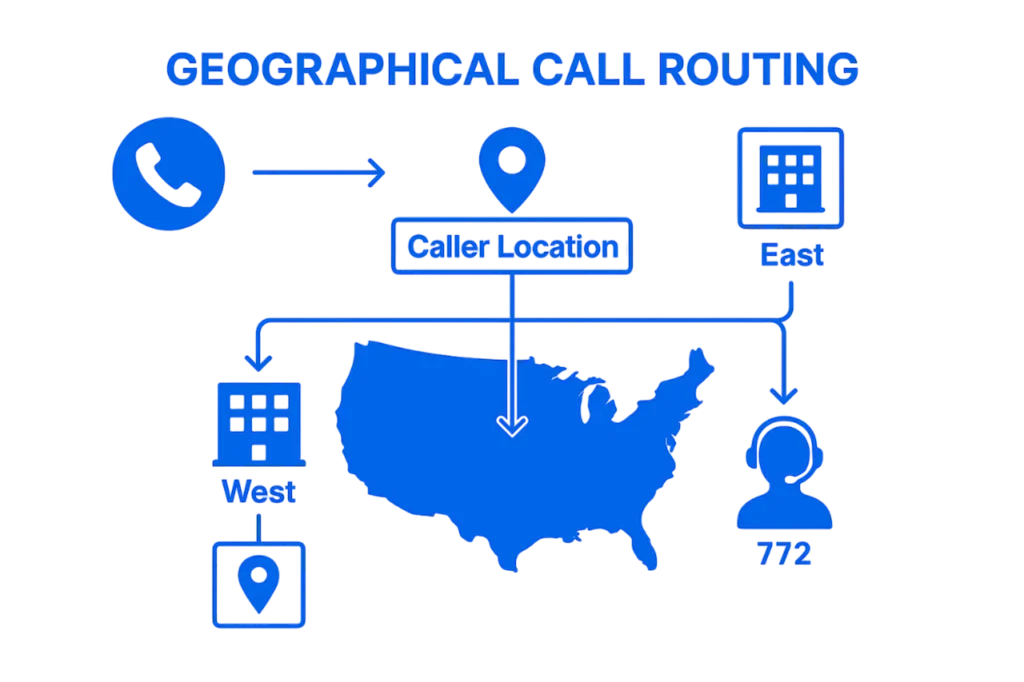
Calls are directed depending on where the caller is, using things like area code or even GPS data. This way, people are in touch with someone nearby who knows the local area, understands what customers in that region want, and is familiar with local rules.
7. IVR (Interactive Voice Response)

With IVR routing, callers hear a menu, use their phone keypad, or say what they need to reach the correct department or person. This lets customers choose where to go, so simple questions get answered faster and people spend less time waiting on hold.
8. AI-driven routing
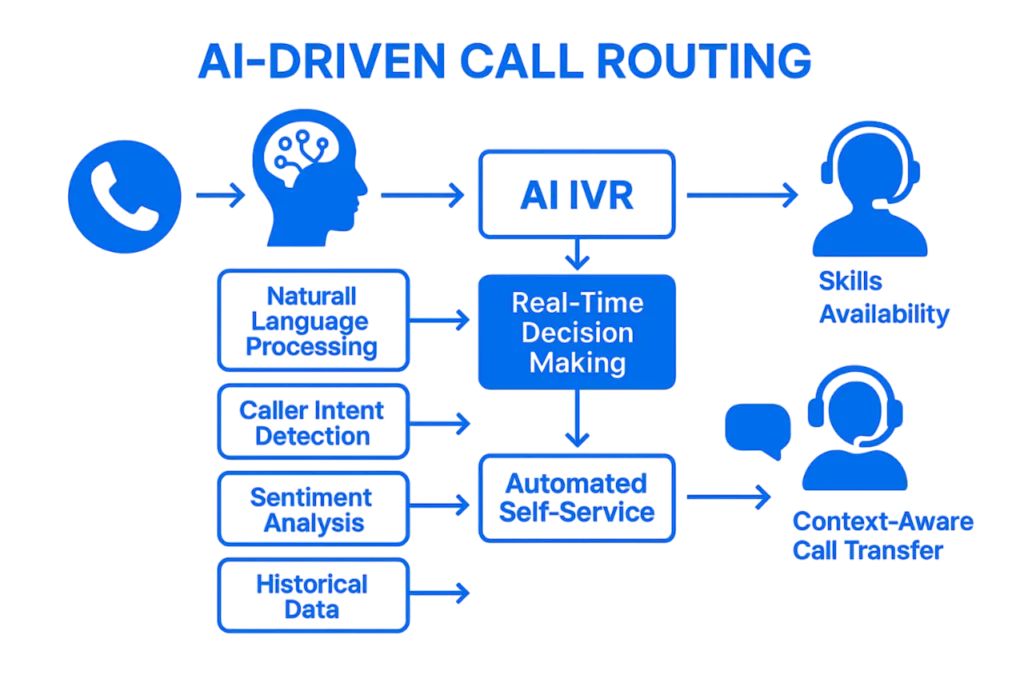
Using AI and analytics, intelligent routing uses customer history, behaviour, and preferences to connect callers with the best-suited agent, sometimes even the same agent they interacted with previously.
Studies show that adopting real-time sentiment analysis can make your business 22% more responsive to customer interactions, enabling you to adapt on the go and address needs as they arise.
| Did you know? According to McKinsey, AI-powered solutions can reduce average handling time by up to 40% and increase first-call resolution rates by 35%. |
Benefits of call routing for your business
Using the right call routing strategy helps deliver a wide range of benefits. Let’s look at some of them:
1. Improved customer experience:
- Reduced wait times through intelligent distribution.
- First-call resolution with skilled agent matching.
- Personalized service based on customer history.
- 24/7 availability with global routing options.
2. Increased efficiency and productivity:
- Automated call distributions save management time.
- Agents handle calls matching their expertise.
- Reduced call transfers and escalations.
- Real-time performance monitoring and optimization.
3. Better resource management:
- Stop overloading some agents while others sit idle – match team capacity to customer needs across phone, chat, and email.
- Let the system redistribute tasks automatically when someone’s swamped or has bandwidth.
- Base scheduling on hard stats (like call patterns) instead of guessing staffing needs.
- Trim operational fat by fixing bottlenecks that waste time/money.
4. Scalability enhanced:
- Easy to add new agents and departments as your team grows.
- Flexible call routing options that can adapt as your business expands.
- Cloud-based solutions for unlimited scaling.
- Integration with existing business systems.
| Want to take it a step further? Integrating SMS into your routing strategy can boost agent productivity and open a new channel for effective customer interactions. Send texts from the call center or use interactive MMS messages. Explore our complete guide to text messaging software to see if it fits into your modern omnichannel approach. |
Tips for choosing the right call routing platform
- Analyze your business needs: Start by closely examining what your business needs. Consider how many calls you handle, what your customers expect when they reach out, and how your team is set up.
- Prioritize flexibility and scalability: Pick a system that won’t box you in; you want something that can handle more calls and new team members as your business grows and adjust easily if your needs change.
- Look for integration capabilities: It is also smart to ensure your call routing setup goes smoothly with your other tools, like your CRM and analytics. Hence, everything fits together, and your team isn’t jumping between disconnected systems.
- AI and analytics: Modern routing solutions with AI can optimize call distribution and continuously improve performance.
- Customize routing rules: Opt for platforms that easily adjust rules to match evolving business objectives.
- Support omnichannel routing: If you handle calls, chats, and emails, choose a solution that unifies routing across all channels. Platforms like Gaglers make it easier to manage customer interactions in one place, ensuring consistent service and faster resolutions no matter how customers reach out.
- Monitor and optimize performance: Regularly review routing performance and adjust strategies based on real-time data and customer feedback.
How to set up a call routing
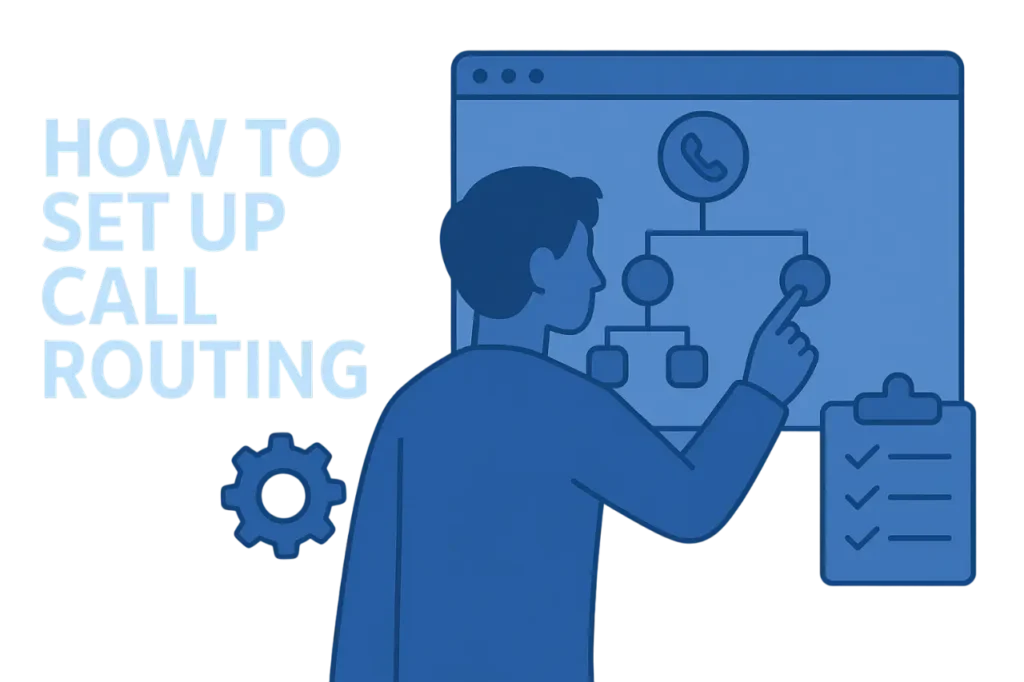
Follow these steps to implement an effective call routing system:
1. Analyze your business needs.Look closely at how many calls you’re getting, when your busiest times are, what your agents are good at, and who your customers are. Figure out where things aren’t working well, and decide how you’ll measure improvements. |
2. Choose a call routing strategy.Select the routing method that best fits your business model. Consider factors like team size, customer types, service complexity, and operational hours. |
3. Select a call routing platform.Evaluate different platforms based on features, scalability, integration capabilities, cost, and vendor support. Consider cloud-based solutions for flexibility. |
4. Set up routing rules.Configure your routing logic, including priority settings, skill-based assignments, time-based rules, and overflow procedures. Test different scenarios thoroughly. |
5. Implement workflow automation.Automate routine tasks within the call routing process, like logging call details, triggering follow-up messages, or escalating urgent cases automatically. This reduces manual work and speeds up customer service. |
6. Test the system.Conduct comprehensive testing with various call scenarios, peak load conditions, and edge cases. Involve your team in testing to identify potential issues. |
7. Train your team.Provide thorough training on the new system, including handling routed calls, using new features, and troubleshooting common issues. |
8. Monitor and optimize.Continuously monitor performance metrics, gather feedback, and make adjustments with Gaglers analytics and reporting. Regular optimization ensures ongoing effectiveness and customer satisfaction. |
Ready to take the next step?
Successful call routing isn’t about choosing the flashiest system but finding the right fit for your business. Want to ensure your call center continues to deliver exceptional results? Dive into our latest call center monitoring tips and discover how real-time analytics and actionable insights can help you fine-tune your operations for lasting success.
| Disclaimer: All images in this blog are AI-generated and are intended for illustrative purposes only. |
